Many beginners are confused when asked 'full margin or isolated margin' during contract trading. What's even scarier is that some people dare to leverage without understanding the basic differences, resulting in liquidation without knowing why. Today, we will clarify these two modes in the simplest way, allowing you to trade clearly.
1. Isolated margin mode: Draw a circle around the risk
- Core feature: Single loss will not exceed the margin of that position
- Example: If the account has 5000U, and a single investment of 500U, the maximum loss is just this 500U
- Advantage analysis:
✓ Strict risk isolation
✓ Avoid chain liquidation
✓ Suitable for practice trading
- Target audience: Beginners, conservative traders, multi-strategy testing phase
2. Full margin mode: A double-edged sword
- Operating mechanism: All funds in the account serve as collateral for positions
- Potential risks:
→ Single loss may swallow the entire account
→ The 'lifesaving' feature easily leads to complacency
→ In extreme market conditions, it may instantly go to zero
- Blood and tears lessons:
Many holders think 'I can still hold', but a single black swan event can wipe everything out, especially those players who don't like to set stop-loss.
3. Selection guide (must-read for beginners)
1. Beginner stage: Force yourself to only use isolated margin
2. Advanced conditions: When you can achieve:
- Strict stop-loss discipline
- Stable trading system
- Reasonable position management
Consider full margin again
3. Golden rule:
Even if using full margin, you must set stop-loss! This is not a suggestion, it's a lifesaving clause.
Important reminder:
The essence of contract trading is a risk management game, not a gamble. I've seen too many people:
✖ Treating full margin as a 'get out of jail free' card
✖ Using isolated margin but heavily leveraged
✖ Completely unaware of margin calculation
These are all giving money to the market.
If you really want to turn things around in this market cycle, now is the time to:
1. Thoroughly understand these basic rules
2. Establish your own risk control system
3. Use a simulation account to verify repeatedly
Instead of using real money to pay tuition.
I am @天机看势 , skilled in medium and short-term contract trading, follow my daily sharing of investment techniques and detailed strategies.
